|
|
|
Sort Order |
|
|
|
Items / Page
|
|
|
|
|
|
|
| Srl | Item |
| 1 |
ID:
130613


|
|
|
|
|
| Publication |
2014.
|
| Summary/Abstract |
"Historians believe that historical essays have nothing to do with the science of history and are actually harmful. Indeed, authors of such essays, whether intentionally or unintentionally, leave traces of themselves and their time. The same is true of editorials and reviews found in today's newspapers." ' The Origins of the Japan-China Territorial Issue, a new book by Mr. Murata Tadayoshi, an honorary professor at Japan' s Yokohama National University is also an example of what the Contemporary Historian, Mr. Chen Yinke, was referring to in the above. It is common knowledge that after Japan's Noda cabinet adopted its "nationalization" policy over the Diaoyu Islands on September ll, 2012, the Sino-Japan relationship began a downward spiral, while rivalry between non-govemment groups from both nations escalated. The Diaoyu
Islands dispute has become a hot topic for both the media and academia. Among the many works on the topic, Professor Murata's is quite unusual. While tensions remain high between China and Japan, his book carries an impressive argument as shown by work's subtitle-FaZsz?ed Facts in Japanese Government Papers. The cover of the book also features the question--"Are the Diaoyu Islands an inherent part of Japan's territory?"
|
|
|
|
|
|
|
|
|
|
|
|
|
|
|
|
| 2 |
ID:
132077


|
|
|
|
|
| Publication |
2014.
|
| Summary/Abstract |
This article intends to fill a glaring void in the existing academic literature on the issues and challenges which stem not only from crafting, but also making asymmetric federalism work in northeast India. It examines the extent and limits to which asymmetric federalism-specifically under Article 371A of India's Constitution-not only negotiates Nagas' sovereignty claims over their land and resources and caters to the demands of democratic justice, but also the extent to which it consolidates India's state-nation and democracy building in its northeastern periphery. Contending that the extant asymmetric federal arrangement in India's polity stems from a centralist federal framework, the article makes a case for a more robust asymmetric federalism, which goes beyond this framework.
|
|
|
|
|
|
|
|
|
|
|
|
|
|
|
|
| 3 |
ID:
132340
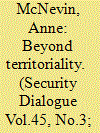

|
|
|
|
|
| Publication |
2014.
|
| Summary/Abstract |
The key contention of this article is that contemporary practices of border security threaten to outrun the explanatory capacity of the spatial (territorial) and subject (citizen/migrant) registers habitually employed to think through human mobility. This represents a political problem as much as an empirical one. First, it implies that migration scholarship deploying categories of analysis informed by prevailing registers offers a limited perspective on contemporary techniques of migration governance; second, it suggests that such scholarship obscures the operation of power that works to enforce profoundly unequal hierarchies of mobility and represent them as politically neutral. In this article, I propose that resisting reversion to problematic categories of analysis offers the potential to think of human mobility without the state and territory as its foremost container concepts. I contend that such an approach - 'beyond territoriality' - is a crucial step on the way to negotiating the normative dimensions of border politics. The case is developed empirically via a grounded investigation of the mundane yet symptomatic practices of border security on the Indonesian island of Bintan.
|
|
|
|
|
|
|
|
|
|
|
|
|
|
|
|
| 4 |
ID:
131979


|
|
|
|
|
| Publication |
2014.
|
| Summary/Abstract |
We know little of the internal governing practices of non-state actors once in control of territory. Some territories have witnessed the establishment of new institutions of public goods remarkably similar to state institutions. This article compares four armed political parties governing territory during the Lebanese civil war. These non-state violent actors established complex political and economic institutions and administrative structures. Despite the wide range of ideologies and identities of these actors, they all converged in their institutional priorities, although not in their capacities or the particular ways of achieving those priorities. Data from interviews and the actions of the armed political parties suggest a combination of ideology and desire for control is causal in generating public institutions, partly attributable to the high degree of citizen activism marking the Lebanese case.
|
|
|
|
|
|
|
|
|
|
|
|
|
|
|
|
| 5 |
ID:
132813
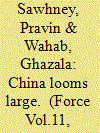

|
|
|
|
|
| Publication |
2014.
|
| Summary/Abstract |
India's national security, especially its defence preparedness against Pakistan and China, with whom it has disputed border, is passing through a disturbing phase. Pakistan continues with cross border terrorism into Jammu and Kashmir, while China infringes upon Indian land and air space from Ladakh to Arunachal Pradesh at will. Both have made a mockery of the military-held lines with India.
Speaking in Parliament during the recent budget session, defence minister Arun Jaitley expressed satisfaction regarding the two disputed borders. According to him, the Indian Army has minimised infiltration across the Line of Control and terrorism in the hinterland with a mix of good anti-infiltration deployment, monitoring and surveillance means, and the fence. Chinese intrusions, he said, are because of differing perception of the disputed border by the two countries.
Do we want better detection and elimination of terrorists in Kashmir, or do we want to compel Pakistan to stop infiltration? If India does not intrude into Chinese land, why should China do this to India regularly?
India seems to have accepted low defence thresholds against both neighbours. This is worrisome. If Pakistan and China are not deterred by India and its military power, especially boots on the ground, will India's two-front war strategy work to compel them? Why is India spending nearly USD 49 billion annually, which excludes defence pensions and nuclear weapons capability, on defence when it appears blunted? Is there a way out for India without going to war with either or both?
India needs a transformation of its national security and defence thinking. It must know that China rather than Pakistan is its irreconcilable adversary, and the disputed border with China is India's singular core concern which impedes India's rise. Once this is grasped, a new approach to policy-making and warfare would emerge. China could be balanced by a political-military methodology, while peace could be made with Pakistan. India's warfare practised so far would alter drastically. With China as the main adversary, India would no longer be preparing to fight the last war better. With more domains like space, cyber, ballistic and cruise missiles, irregular warriors (terrorists) and nuclear weapons added to the conventional combat on land, air and sea, India will need different higher defence organisation and higher strategic organisation from those proposed so far. All this can be done without raising either annual defence allocations or ringing alarm bells in the region.
|
|
|
|
|
|
|
|
|
|
|
|
|
|
|
|
| 6 |
ID:
133977
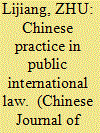

|
|
|
|
|
| Publication |
2014.
|
| Summary/Abstract |
This Survey covers materials reflecting Chinese practice in 2013 relating to: Fundamental Principles of International Law (The Principle of Equality of State Sovereignty; Permanent Sovereignty over Natural Resources; Prohibition of Threat or Use of Force; Peaceful Settlement of International Disputes; Non-intervention in Internal Affairs); Sources of International Law (Identification of Customary International Law; Guide to Practice on Reservations to Treaties; Provisional Application of Treaties); Relationship between International Law and Chinese Law (Act on Administration of Tax Collection Revised; Act on the Prevention and Control of Environmental Pollution by Solid Wastes Revised; Act on Seed Revised; Act on Animal Epidemic Prevention Revised; Act on Trade Mark Revised; Act on Fishery Revised; Act on Marine Environment Protection Revised; Act on Customs Revised); Recognition of New States (Palestine; Kosovo); Jurisdiction and Immunity (Scope and Application of Universal Jurisdiction; Immunity of State Officials from Foreign Criminal Jurisdiction); China's Territorial Integrity (Taiwan; Tibet; China-India Border; Diaoyu Island and its Affiliated Islands; Nansha Islands); Polar Regions (Arctic Council; Antarctic Treaty); International Law of the Sea (Submission to the Commission on the Limits of the Continental Shelf in part of the East China Sea; Commission on the Limits of the Continental Shelf (CLCS); International Seabed Authority (ISA); International Tribunal for the Law of the Sea (ITLOS); Marine Biodiversity beyond Areas of National Jurisdiction; Reorganization of State Ocean Administration); International Air and Space Law (Establishment of Air Defense Identification Zone in East China Sea; Peaceful Use of Outer Space; Transparency and Confidence-Building Measures in Outer Space; International Code of Conduct for Outer Space Activities); International Cyberspace Law (International Code of Conduct for Information Security; Cyber Crime); Aliens (Regulation on Administration of Exit and Entry); International Human Rights Law (Universal Periodic Review; Office of the High Commissioner for Human Rights (OHCHR); International Covenant on Civil and Political Rights (ICCPR); Convention against Torture and Other Cruel Inhuman or Degrading Treatment or Punishment (CAT); Convention on the Rights of the Child (CRC); Human Rights Treaty Bodies and Their Reform; Rights of Indigenous Peoples; Action Plan for Fighting Human Trafficking (2013-2020)); International Humanitarian Law (Protection of Civilians in Armed Conflicts; Protection of Journalists in Armed Conflicts); International Law on Disasters (Protection of Persons in the Event of Disasters); International Law on Arms Control, Disarmament and Non-proliferation (Nuclear Disarmament and Non-Proliferation; Chemical Weapons Convention; Biological Weapons Convention (BWC); Convention on Certain Conventional Weapons (CCW); Amended Protocol II to the CCW; Ottawa Convention; Convention on Cluster Munitions (CCM); Protocol V to the CCW (ERW); Improvised Explosive Devices (IEDs); Lethal Autonomous Robots; Arms Trade Treaty (ATT); Small Arms and Light Weapons; Conference on Disarmament (CD)); International Criminal Law (Crimes against Humanity; International Criminal Court (ICC); ICTY and ICTR; UN Comprehensive Convention against Terrorism; Agreement on the Procedure for Organizing and Conducting Joint Anti-Terrorist Exercises by Member States of the Shanghai Cooperation Organization; Agreement on the Procedure for Organizing and Conducting Joint Anti-Terrorist Operations within Member States of the Shanghai Cooperation Organization; Trafficking in Cultural Property; Ratification of the Treaty on Transfer of the Convicted between the People's Republic of China and the Republic of Kyrgyzstan; International Criminal Judicial Assistance and Police Cooperation); International Environmental Law (Climate Change; Sustainable Development; Protection of Atmosphere; Action Plan on Air Pollutio
|
|
|
|
|
|
|
|
|
|
|
|
|
|
|
|
| 7 |
ID:
128395
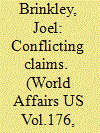

|
|
|
|
|
| Publication |
2014.
|
| Summary/Abstract |
Most everyone has heard of the South China Sea debate, the enduring argument between China and most every other state that has a coastline on that waterway. From Indonesia to the Philippines, every state is angry with China over its claim that it maintains full ownership rights to nearly all of the sea's islands and resources.
|
|
|
|
|
|
|
|
|
|
|
|
|
|
|
|
| 8 |
ID:
131596
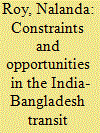

|
|
|
|
|
| Publication |
2013.
|
| Summary/Abstract |
This research note explores the transit issue that has become one of the most problematic disputes overtime between India and Bangladesh. It also analyzes its long-term implication in the bilateral relations between them. The history dates back to the pre independence period when Bangladesh and India were part of the British colony. The roads_. water and railways were then integrated in the communication system. The outlets to the sea were through Chittagong port or via the rivers of Bangladesh reaching the ports of Kolkata. India had pressed Bangladesh to provide transit facilities through the hearts of Bangladesh to connect West Bengal in the west and Tripura in the east. India claims that it will use this transit facility solely for the transport of ?eight and goods between two remotely connected parts of India. But Bangladesh has persistently denied any such agreement earing it as a threat to national security.
|
|
|
|
|
|
|
|
|
|
|
|
|
|
|
|
| 9 |
ID:
131004
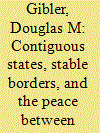

|
|
|
|
|
| Publication |
2014.
|
| Summary/Abstract |
Park and Colaresi find that border stability does not apply to non-contiguous states. This just confirms, again, an argument I have been making in numerous publications since my original "Bordering on Peace" article. Nevertheless, I use this response to present a replication of my original argument, as it applies to contiguous states, and I find strong support for the contention that the democratic peace can better be understood as a stable border peace. I also discuss several different replications of the original argument using different proxies for stable borders. Each confirms that joint democracy is not a statistically significant predictor of conflict once stable borders are also included in the model. In sum, arguments from the territorial peace have been confirmed in multiple analyses, with multiple data sets, using multiple levels of analysis, and this renders Park and Colaresi's attack on the original "Bordering on Peace" a non sequitur in the debate over stable borders as an explanation of democracy and peace.
|
|
|
|
|
|
|
|
|
|
|
|
|
|
|
|
| 10 |
ID:
132468
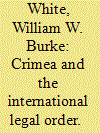

|
|
|
|
|
| Publication |
2014.
|
| Summary/Abstract |
Putin's exploitation of the tension between the principles of non-intervention and self-determination is in the tradition of great-power interaction with international law. But Russia's interpretation sets dangerous precedents.
Crimea is Russia's. The March 2014 referendum and Russia's subsequent annexation of Crimea are now events of history, even while the territorial borders and political future of the rest of Ukraine remain contested. Yet, as international attention has moved from Sevastopol to Kiev and more recent crises elsewhere, a key balance between two of the most fundamental principles of the post-Second World War international legal and political order remains at stake.
|
|
|
|
|
|
|
|
|
|
|
|
|
|
|
|
| 11 |
ID:
088758


|
|
|
|
|
| Publication |
2009.
|
| Summary/Abstract |
The awarding of the 2008 Nobel Peace Prize to former President Martti Ahtisaari, Finland, cites his involvement in the settlement of the Aceh conflict. This at the same time highlights the lack of such efforts in the regions of Southeast Asia and the South Pacific. While internal conflicts throughout the world often tend to be resilient to conflict management initiatives, conflicts in the Asia-Pacific region have proven to be particularly difficult to resolve. Internal conflicts in Southeast Asia and the Pacific often concern territorial issue, for instance, East Timor and ethnically based conflicts in Myanmar. This is also true for conflicts in the South Pacific, notably in Bougainville (Papua New Guinea) and New Caledonia (France). Territorial conflicts last longer, are more difficult to manage, and generally produce more adverse consequences than those over other issues such as ideology, government, and national power.
|
|
|
|
|
|
|
|
|
|
|
|
|
|
|
|
| 12 |
ID:
132526
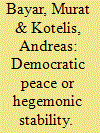

|
|
|
|
|
| Publication |
2014.
|
| Summary/Abstract |
Democratic peace theory (DPT) and hegemonic stability theory provide different explanations for cooperation among (democratic) states. The Imia/Kardak crisis took place between Greece and Turkey, two democratic, nonnuclear, and interdependent states in the post-Cold War era, thus, offers rare insights into these theorized processes. During this crisis, democratic actors and issues contributed to escalation, whereas war was prevented in the last minute by the coercive diplomacy of the USA. Based on our archival research in Greece and Turkey, our findings pose a challenge to the validity of the DPT for democratic dyads with territorial conflicts.
|
|
|
|
|
|
|
|
|
|
|
|
|
|
|
|
| 13 |
ID:
110537


|
|
|
|
|
| Publication |
2011.
|
| Summary/Abstract |
In this article, we explain the role of international law in the resolution of territorial disputes from 1945 to 2000. In doing so, we focus on three outcomes of interest. First, when do states choose to revise the territorial status quo through negotiations instead of force? Second, when are states able to reach a final settlement? Third, when do states prefer a process of legal dispute resolution (i.e., adjudication or arbitration) to bilateral negotiations? To answer these questions, we argue that when the legal principles relevant to the dispute are unambiguous and clearly favor one side, a law-based focal point will emerge. This focal point, in turn, facilitates the settlement process by helping leaders overcome distribution problems, a central obstacle in reaching a final agreement. We find strong and consistent empirical support for our hypotheses regarding international law and peaceful dispute resolution.
|
|
|
|
|
|
|
|
|
|
|
|
|
|
|
|
| 14 |
ID:
133778
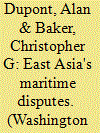

|
|
|
|
|
| Publication |
2014.
|
| Summary/Abstract |
Few doubt that China's rise is this era's principal driver of strategic change, just as the United States' equally influential ascendancy shaped the last. But earlier optimism that the Middle Kingdom's re-emergence as a major power would be largely benign is fading as evidence mounts that Beijing is determined to press its territorial and resource claims in the vitally important seas of the Western Pacific. In barely the blink of a geopolitical eye, China's once lauded charm offensive has given way to exactly the kind of coercive behavior its critics have long predicted.1 In a 3,000-mile maritime arc running from the East China Sea to the southern reaches of the South China Sea, Beijing is at loggerheads with many of its neighbors, including erstwhile friends, over several linked territorial and resource disputes. If not wisely managed, these disputes could bring East Asia's long peace to a premature and bloody end.
|
|
|
|
|
|
|
|
|
|
|
|
|
|
|
|
| 15 |
ID:
137340
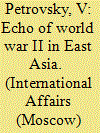

|
|
|
|
|
| Summary/Abstract |
THE UNSTABLE SITUATION in East Asia and the Asia-Pacific region, the presence of unresolved territorial disputes and conflicts, and the lack of regional security and cooperation mechanisms have their roots in the events of recent history in the second half of the 20th century and stem from the related historical and geopolitical tensions.
|
|
|
|
|
|
|
|
|
|
|
|
|
|
|
|
| 16 |
ID:
139195
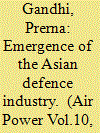

|
|
|
|
|
| Summary/Abstract |
East Asia is a region of contradictions. While it contributes an equal share to world Gross Domestic Product (GDP) as North America, it is also home to four flashpoints: the Taiwan Straits, Korean Peninsula, East China Sea and South China Sea. Countries in the region are bound to each other by economic linkages through trade and production networks, which have led the region to have a joint stake in its shared prosperity. However, increasing economic interdependence, while being a deterrent for conflict, falls short of becoming a cause for peace. Inability to resolve the historical legacies and boundary disputes, the competition for resources, the rise of China, the US pivot to Asia, the unstable regime of North Korea and the changing Japanese security identity are some of the multifarious security problems for the region. This constant clash of strategic aspirations to dominate the region ensures that military instruments will play a critical role in Asia.
|
|
|
|
|
|
|
|
|
|
|
|
|
|
|
|
| 17 |
ID:
130599


|
|
|
|
|
| Publication |
2014.
|
| Summary/Abstract |
The centre of gravity of international relations is shifting to Asia Pacific. The Asian region has been characterized by intense cold war rivalries; numerous territorial and maritime disputes, undemocratic A and oppressive regimes. The United States has been involved as an 'anchor of security in the region. Asian countries have seen acute financial crisis in the past. Many countries have been victims of terrorism, insurgencies, militancy, and fundamentalism. Resource Iigompetition is intensifying. Proliferation of weapons of mass destruction (WMD), presents a threat to the region. The past has "also been tainted with massive violence and bloodshed. The Korean _?._are claimed two million lives and the Vietnam War took three million fives. Internal pogroms by Khmer rouge claimed two million lives. .me of these issues like the divided Korean peninsula and the cross- t tensions between China and Taiwan still persist. The region
[nines to face formidable security challenges.
|
|
|
|
|
|
|
|
|
|
|
|
|
|
|
|
| 18 |
ID:
132260
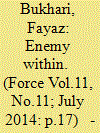

|
|
|
|
|
| Publication |
2014.
|
| Summary/Abstract |
This year the Indian Army achieved a major success by killing 41 militants including 11 top commanders of Lashkar-e-Toiba (LeT), Jaish-e-Mohammad (JeM) and Hizbul Mujahideen (HM) and arrested 23 of them in joint operations with the police.
The figures reveal that this is more than the number of militants neutralised last year, but over the years killing of militants is not making much of a difference as new recruits replace them.
Lieutenant General Subrata Saha, who took over as the General Officer Commanding (GOC) of Army's strategic Chinar Corps or 15 Corps, responsible for tackling militancy in Kashmir besides guarding the Line of Control (LC), has a bigger challenge ahead. For him, killing the militancy is a challenge and not counting the dead.
As per the figures given by the Jammu and Kashmir Police, there are 130 active militants in Kashmir valley and if the rate at which they were eliminated this year continues, not a single militant will be left by next year.
Says a senior army officer: "That is not the case, as per our records at least 16 Kashmiri youth, mostly educated, joined militancy this year. The numbers could be more than our records. And on an average two-three youth get lured into militancy during the funeral of a militant commander."
|
|
|
|
|
|
|
|
|
|
|
|
|
|
|
|
| 19 |
ID:
168863
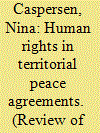

|
|
|
|
|
| Summary/Abstract |
Justice and peace are commonly seen as mutually reinforcing, and key international peacebuilding documents stress the importance of human rights. Is this apparent normative shift reflected in post-Cold War peace agreements? The existing literature is divided on this issue but has crucially treated both conflicts and peace agreements as aggregate categories. This article argues that the conflict type and the agreement's ‘core deal’ impact on the inclusion, or exclusion, of human rights provisions. Based on new coding of the 29 comprehensive agreements signed between 1990 and 2010, it compares agreements signed in territorial and non-territorial conflicts, and agreements with and without territorial autonomy. Qualitative Comparative Analysis is used to examine the different combinations of conditions that led to the inclusion of human rights. The analysis finds that agreements signed in territorial conflicts are significantly less likely to include effective human rights provisions, especially if the settlement includes territorial autonomy. Moreover, such provisions tend to be the result of high levels of international involvement, and the consequent lack of local commitment, or outright resistance, undermines their implementation. These findings point to important trade-offs between group rights and individual rights, and qualifies the notion of a liberal peace.
|
|
|
|
|
|
|
|
|
|
|
|
|
|
|
|
| 20 |
ID:
132403
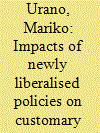

|
|
|
|
|
| Publication |
2014.
|
| Summary/Abstract |
Based on interviews and participant observation conducted in the province of East Kalimantan, Indonesia, from 2008 to 2012, this paper examines why the agrarian reforms have failed to secure the land rights of local farmers. Since the fall of the authoritarian government in 1998, Indonesia has seen limited, but growing government recognition of customary land rights of local farmers living in forest areas. I present a case study of two villages, in which the greater discretion on the part of the local community to negotiate with large-scale oil palm estates has led to the abuse of power by local elites, as well as territorial tensions between local communities. The finding questions the optimistic view that state recognition of customary land rights of communities would automatically lead to the security of landownership of local farmers, and its underlying image of harmonious local communities in which members share coherent interests. The agrarian reform that has centred on communities' rights of control over land and natural resources is problematic. When local communities do not possess capabilities for resolving conflicts in an equitable and transparent manner, third-party intervention is needed to assist communities to strengthen local land rights.
|
|
|
|
|
|
|
|
|
|
|
|
|
|
|
|
|
|
|
|
|